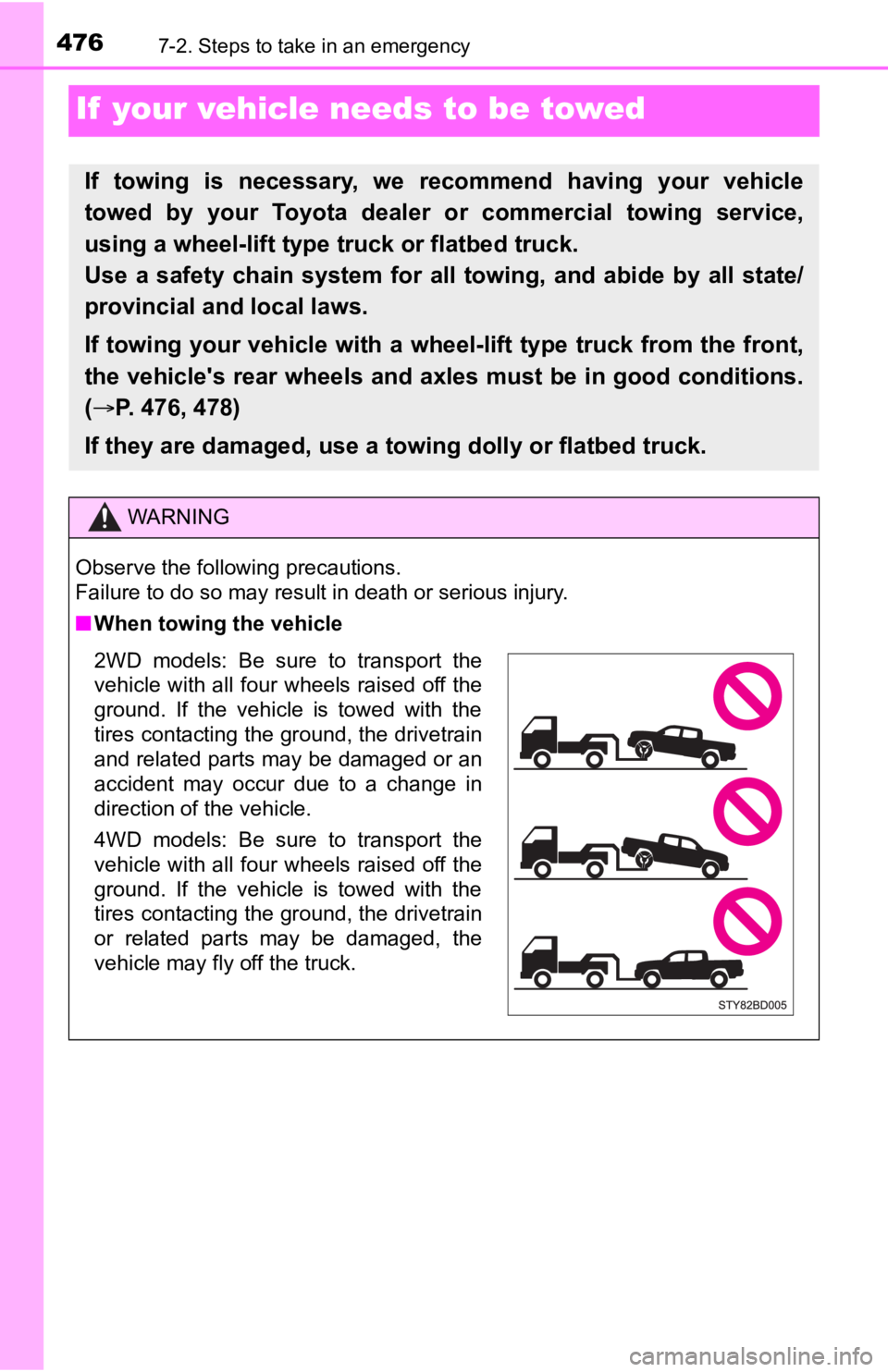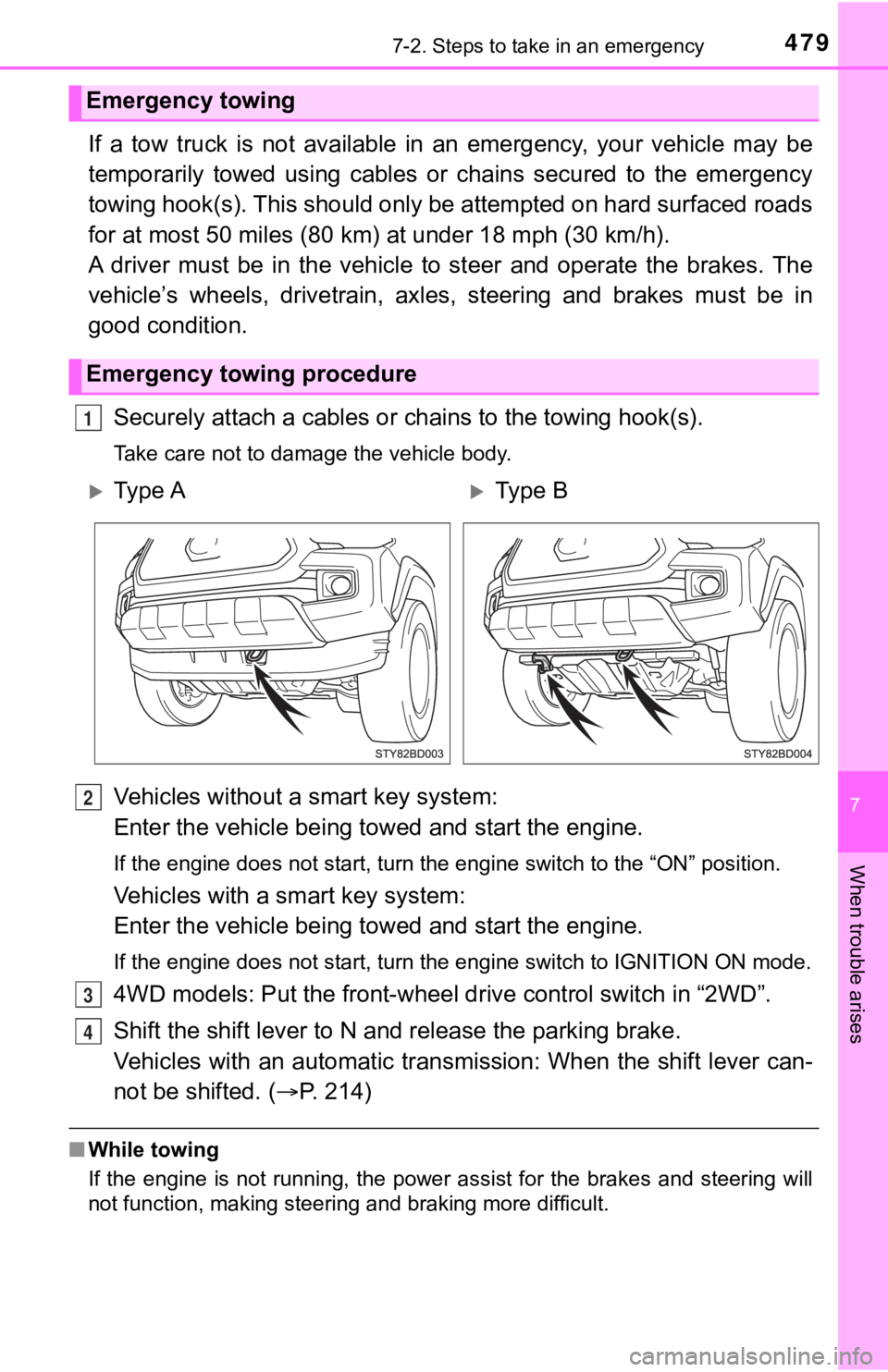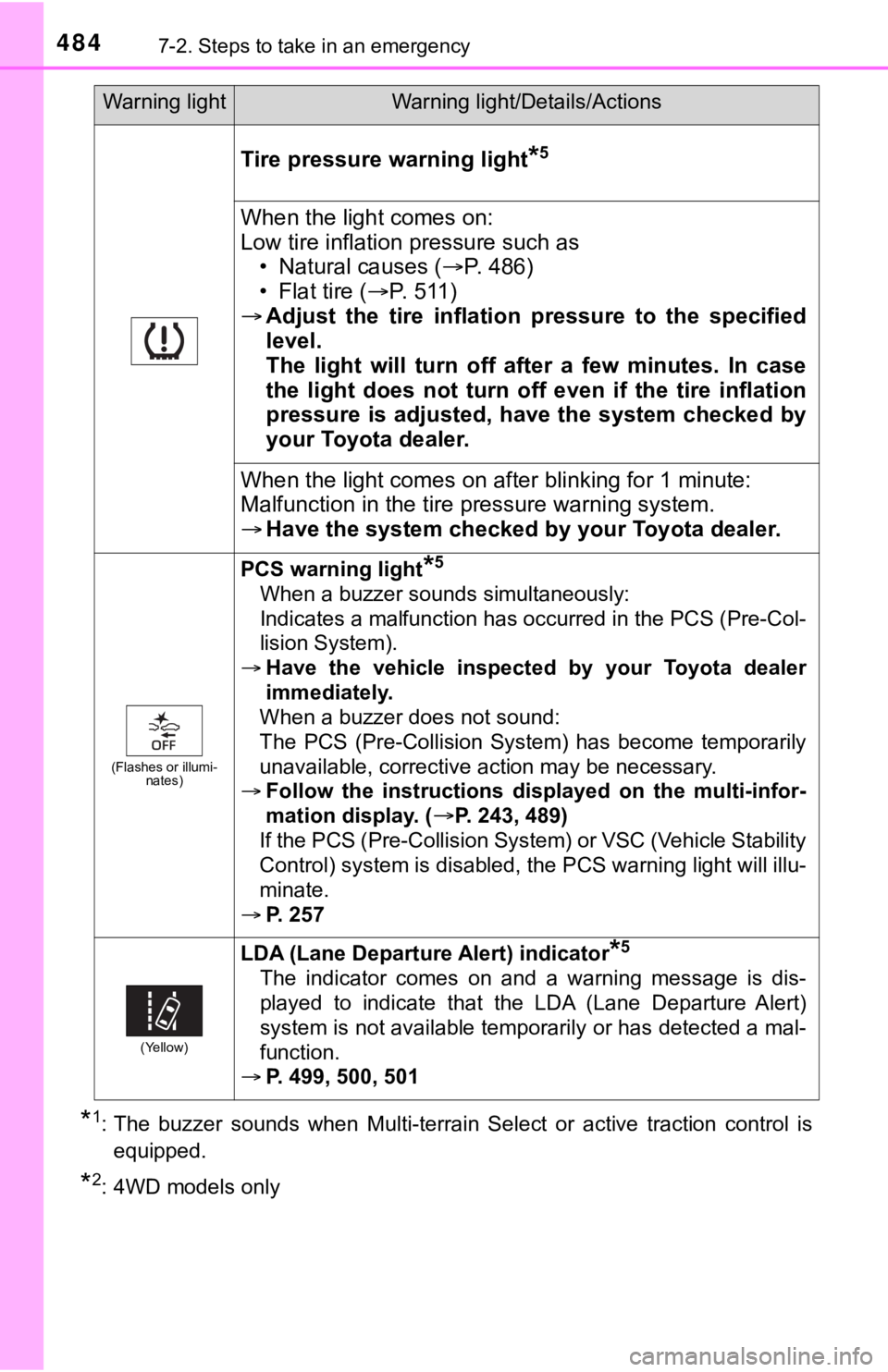Page 476 of 616

4767-2. Steps to take in an emergency
If your vehicle needs to be towed
If towing is necessary, we recommend having your vehicle
towed by your Toyota dealer or commercial towing service,
using a wheel-lift type t ruck or flatbed truck.
Use a safety chain system for all towing, and abide by all stat e/
provincial and local laws.
If towing your vehicle with a wheel-lift type truck from the fr ont,
the vehicle's rear wheels and axles must be in good conditions.
( P. 476, 478)
If they are damaged, use a towing dolly or flatbed truck.
WARNING
Observe the following precautions.
Failure to do so may result in death or serious injury.
■ When towing the vehicle
2WD models: Be sure to transport the
vehicle with all four wheels raised off the
ground. If the vehicle is towed with the
tires contacting the ground, the drivetrain
and related parts may be damaged or an
accident may occur due to a change in
direction of the vehicle.
4WD models: Be sure to transport the
vehicle with all four wheels raised off the
ground. If the vehicle is towed with the
tires contacting the ground, the drivetrain
or related parts may be damaged, the
vehicle may fly off the truck.
Page 479 of 616

4797-2. Steps to take in an emergency
7
When trouble arises
If a tow truck is not available in an emergency, your vehicle may be
temporarily towed using cables or chains secured to the emergen cy
towing hook(s). This should only be attempted on hard surfaced roads
for at most 50 miles (80 km) at under 18 mph (30 km/h).
A driver must be in the vehicle to steer and operate the brakes . The
vehicle’s wheels, drivetrain, axles, steering and brakes must b e in
good condition.
Securely attach a cables or chains to the towing hook(s).
Take care not to damage the vehicle body.
Vehicles without a smart key system:
Enter the vehicle being towed and start the engine.
If the engine does not start, turn the engine switch to the “ON ” position.
Vehicles with a smart key system:
Enter the vehicle being towed and start the engine.
If the engine does not start, turn the engine switch to IGNITIO N ON mode.
4WD models: Put the front-wheel drive control switch in “2WD”.
Shift the shift lever to N and release the parking brake.
Vehicles with an automatic trans mission: When the shift lever can-
not be shifted. ( P. 214)
■While towing
If the engine is not running, the power assist for the brakes a nd steering will
not function, making steering and braking more difficult.
Emergency towing
Emergency towing procedure
1
Ty p e AType B
2
3
4
Page 484 of 616

4847-2. Steps to take in an emergency
*1: The buzzer sounds when Multi-terrain Select or active traction control is
equipped.
*2: 4WD models only
Tire pressure warning light*5
When the light comes on:
Low tire inflation pressure such as • Natural causes ( P. 4 8 6 )
• Flat tire ( P. 511)
Adjust the tire inflation pressure to the specified
level.
The light will turn off after a few minutes. In case
the light does not turn off even if the tire inflation
pressure is adjusted, have the system checked by
your Toyota dealer.
When the light comes on af ter blinking for 1 minute:
Malfunction in the tire p ressure warning system.
Have the system checked by your Toyota dealer.
(Flashes or illumi-
nates)
PCS warning light*5
When a buzzer sounds simultaneously:
Indicates a malfunction has occurred in the PCS (Pre-Col-
lision System).
Have the vehicle inspected by your Toyota dealer
immediately.
When a buzzer does not sound:
The PCS (Pre-Collision System) has become temporarily
unavailable, corrective action may be necessary.
Follow the instructions displayed on the multi-infor-
mation display. (
P. 243, 489)
If the PCS (Pre-Collision System) or VSC (Vehicle Stability
Control) system is disabled, the PCS warning light will illu-
minate.
P. 257
(Yellow)
LDA (Lane Departur e Alert) indicator*5
The indicator comes on and a warning message is dis-
played to indicate that the LDA (Lane Departure Alert)
system is not available temporarily or has detected a mal-
function.
P. 499, 500, 501
Warning lightWarning light/Details/Actions
Page 494 of 616
4947-2. Steps to take in an emergency
(4WD models only)
Indicates that the transfer mode may not suc-
cessfully change.
Operate the front-wheel drive control
switch again. ( P. 303)
(4WD models only)
Indicates that the front differential oil temperature
is too high.
Drop your speed or stop the vehicle until
the message and light go off. If the mes-
sage and light do not go off, contact your
Toyota dealer.
(4WD models only)
Indicates that the front differential oil temperature
is too high.
Turn the front-wheel drive control switch to
“2WD” ( P. 303) and drop your speed or
stop the vehicle until the message and light
go off. If the message and light do not go
off, contact your Toyota dealer.
(If equipped)
Indicates that the Crawl Control is canceled while
in use. A buzzer also sounds.
Use the Crawl Control under the proper
operating conditions. (P. 318)
Warning messageDetails/Actions
(Flashes)
(Flashes)
(Flashes)
Page 499 of 616
4997-2. Steps to take in an emergency
7
When trouble arises
(If equipped)
Indicates that the Multi-terrain Select cannot be
operated because the VSC and/or 4WD system
may be malfunctioning.
Contact your Toyota dealer.
(If equipped)
Indicates that the Multi-terrain Select is canceled
while in use.
A buzzer also sounds.
Use the Multi-terrain Select under the
proper operating conditions. ( P. 314)
(If equipped)
Indicates that the Multi-terrain Select cannot be
operated because Crawl Control is operating.
Turn Crawl Control off. ( P. 318)
(If equipped)
Indicates that your vehicle is nearing the vehicle
ahead (in vehicle-to-vehicle distance control
mode).
A buzzer also sounds.
Slow the vehicle by applying the brakes.
(If equipped)
Indicates a malfunction in the LDA (Lane Depar-
ture Alert).
A buzzer also sounds.
Have the vehicle inspected by your Toyota
dealer.
Warning messageDetails/Actions
(Yellow)
Page 524 of 616

5247-2. Steps to take in an emergency
WARNING
■When using the temporary spare tire
●Remember that the temporary spare tire provided is specifically
designed for use with your vehicle. Do not use your temporary spare
tire on another vehicle.
●Do not use more than one temporary spare tires simultaneously.
●Replace the temporary spare tire with a standard tire as soon a s possi-
ble.
●Avoid sudden acceleration, abrupt steering, sudden braking and shift-
ing operations that cause sudden engine braking.
■When the spare tire is attached
The vehicle speed may not be co rrectly detected, and the following sys-
tems may not operate correctly:
Also, not only can the following system not be utilized fully, but it may
even negatively affect the drive-train components:
• 4WD system
■Speed limit when using th e temporary spare tire
Do not drive at speeds in excess of 50 mph (80 km/h) when a temporary
spare tire is installed on the vehicle.
The temporary spare tire is not designed for driving at high sp eeds. Fail-
ure to observe this precaution may lead to an accident causing death or
serious injury.
• ABS & Brake assist
• VSC
• TRC
• AUTO LSD
• Dynamic radar cruise control
(if equipped)
• Pre-Collision System (if equipped)
• Automatic High Beam (if equipped)
• LDA (Lane Departure Alert) (if
equipped)
• Hill-start assist control
(if equipped)
• Cruise control (if equipped)
• Active traction control system (if equipped)
• Multi Terrain ABS (if equipped)
• Multi-terrain Select (if equipped)
• Crawl Control (if equipped)
• Navigation system (if equipped)
Page 541 of 616
5418-1. Specifications
8
Vehicle specifications
Access Cab models
Double Cab models
Access Cab models
*1: The model code is indicated on the Certification Label. (P. 5 4 3 )
*2: Installing accessories in addition to those installed at the f actory
increases vehicle weight, thereby reducing vehicle capacity wei ght.
Contact your Toyota dealer about the weight of accessory parts.
Seating capacity
Seating capacity
Vehicles without rear seatsVehicles with rear seats
24 (Front 2, Rear 2)
Seating capacity5 (Front 2, Rear 3)
Vehicle capacity weight
Model code*1EngineDriving
systemDeck type
Vehicle capac-
ity weight
(Occupants +
luggage)
*2
TRN265L-CRTSKA 2TR-FE
engine 2WD
Long deck1500 lb.
(680 kg)
TRN245L-CRTSKA 4WD
1300 lb.
(590 kg)
GRN325L-CRTSHA 2GR-FKS engine 2WD
1400 lb.
(635 kg)
GRN305L-CRFSHA 4WD
1100 lb.
(500 kg)
GRN305L-CRTSHA
1150 lb.
(520 kg)
Page 542 of 616
5428-1. Specifications
Double Cab models
*1: The model code is indicated on the Certification Label. (P. 5 4 3 )
*2: Installing accessories in addition to those installed at the f actory
increases vehicle weight, thereby reducing vehicle capacity wei ght.
Contact your Toyota dealer about the weight of accessory parts.
Model code*1EngineDriving
systemDeck type
Vehicle capac- ity weight
(Occupants + luggage)
*2
TRN265L-PRTSKA 2TR-FE
engine
2WDShort
deck1400 lb.
(635 kg)
GRN325L-PRTSHA
2GR-FKS engine
1200 lb.
(545 kg)
GRN325L-PRTLHA
1250 lb.
(565 kg)
GRN330L-PRTSHA Long
deck
1195 lb.
(540 kg)
GRN330L-PRTLHA
1200 lb.
(545 kg)
GRN305L-PRFSHA
4WDShort
deck
945 lb.
(430 kg)
GRN305L-PRTSHA
990 lb.
(450 kg)
GRN305L-PRTLHA
990lb.
(450 kg)
GRN310L-PRTSHA Long
deck
940 lb.
(425 kg)
GRN310L-PRTLHA
945 lb.
(430 kg)